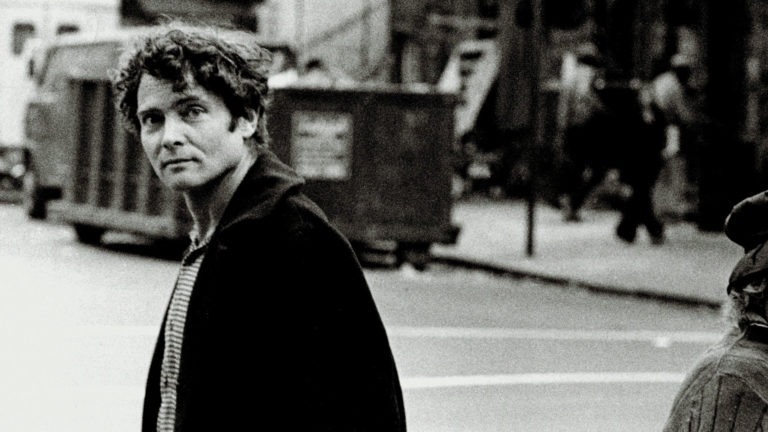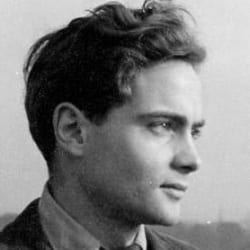
Susan Howe and R.H. Quaytman are mother and daughter, a poet and a painter, both widely admired and fiercely cerebral and quietly a lot of fun. They did not want to do an interview together, and it’s not hard to understand why. What daughter wants a stranger to point out all the ways that she is like her mother? What mother wants to risk eclipse by her daughter’s fame? But their reluctance was more subtle. Howe and Quaytman objected to the idea that the mother-daughter relationship is the most important one in their family. They are only two in a web of artists: Howe’s mother, Mary, was an actress and playwright; Quaytman’s father, Harvey, a painter; Howe’s second husband, the sculptor David von Schlegell; their son, the science fiction writer Mark von Schlegell. Except for Mark, who lives in Germany, all of those people are dead, but no matter; when you are dealing with Howe and Quaytman, hauntings are very much on the table.
Howe is a lauded poet, about as recognized as an American experimental writer can be. She trained as a visual artist, and in the late 1960s began to cut words out of catalogs and typewritten pages and tape them on the wall; soon enough she was printing them in books. In 1985 she published “My Emily Dickinson,” a dense and intricate study in which she parses Dickinson’s manuscripts, which were often written on scraps or envelopes. Whether writing poetry or her highly idiosyncratic criticism, Howe’s process embraces serendipity; she has an eye for what might be overlooked, and often scours special collections for out-of-print or fragile works — Jonathan Edwards’s manuscripts written on the silk paper his wife and daughter used to make fans; William Carlos Williams lines scrawled on a prescription pad. In writing her poems, she jots down her thoughts and dreams in a small black notebook, the inside covers of which contain quotations so that her own words are “embedded and surrounded by ghosts and echoes.”

Quaytman, too, makes work that gets called “difficult.” Her paintings, which often layer silkscreens or color photographs, play with seducing and repelling the viewer’s eye. She uses Op-Art patterns to push away the gaze; sometimes she draws you in by covering her panels with diamond dust that sparkles. Like her mother, Quaytman begins with research; her most recent show involved investigations into Lygia Clark, Clarice Lispector, João Vilanova Artigas, Elizabeth Bishop and Claude Lévi-Strauss. Unlike her mother, she likes rules, which she deploys to help make sure that her paintings are always recognizably hers, even when they are exhibited in what she calls “aggressively present architectures,” such as corporate lobbies. One rule is that “each painting is made in one of seven consistent nesting sizes on plywood panels which are gessoed with the same rabbit-skin glue gesso.” Another is that “each exhibition is a chapter in an ongoing archive that I plan to continue without end.” That is, even as she makes her work, she is thinking about her entire oeuvre, how the pieces will relate to each other and how they will be remembered.
Recently mother and daughter collaborated on “Tom Tit Tot,” a book produced by the Museum of Modern Art. Howe has always loved gruesome fairy tales, and her poems for the book were partly inspired by Paul Thek’s 1975-6 work “The Personal Effects of the Pied Piper,” a scattering of cast-bronze rodents and utensils, the imagined detritus of the campsite where the rat-catcher of Hamelin lured the little children of the town. Quaytman had recommended other artists for the job, but ended up co-designing the book herself. (One of her artworks is uncannily like something Howe would have picked out: a frontispiece called “Temple of Time,” based on an image by Emma Hart Willard, an American educator and activist who lived at the time of the Civil War). Quaytman and Howe are pleased with the book but generally wary of working together. “It’s a dangerous, cutesy idea,” Quaytman said, referring to the mother-daughter thing. “We’re worried about this, too.”
She was talking about me, and this article. Quaytman is a private person who disowns biographical readings of her work. Her professional name — R. H. for Rebecca Howe — honors her mother, but secretly. She asks that gender pronouns not be used in any of her exhibitions’ wall texts. Her conceptualism is part of a feminist project to not reveal her self in her art. “It also began this interesting thing where they had to write press releases about the paintings instead of about me,” she said. Similarly, even when Howe’s work is at its most personal — as when she writes about the death of her third husband, the philosophy professor Peter H. Hare, in “That This” — she always holds something back; the meaning of her writing is never dependent on the facts of her biography.
Quaytman and Howe were eventually persuaded by the idea that poetry could always use a little publicity. We met in Howe’s red-shingled, light-filled home in Guilford, Conn., a marshy town 20 minutes from New Haven. Her furniture is simple and made of curved wood and placed just-so in a manner that seems very New England: cozy, spare, impersonal. During the afternoon I spent with them, they happily talked over each other: about archives; about Mark von Schlegell, whom they both adore; about television; about Victorian novels; about vitrines. They are affectionate, even when in disagreement. For much of the day Quaytman stood back, shaking her head No, no, as Howe went on about this or that.
Quaytman was wearing two necklaces: a paste necklace that belonged to Howe’s mother, with a large, shiny square surrounded by nearly two dozen costume jewels; and a collar of the kind you might find in an S&M shop. She is guarded, but playfully so, and has a habit of answering a question with a joke. Howe is tiny and elfin, with a drawn face and short gray hair and bright eyes. For a self-described recluse, she has a remarkably big, theatrical voice. She talks openly of her anxieties, saying she could never travel like her daughter does, because she’s not “tough” enough — “Oh, this really drives me crazy,” Quaytman interrupted, rolling her eyes in the manner of one long resigned to this difference of opinion.
Growing up in a family like theirs means knowing how to bind a book or how to identify what country a painting is from by its sky — both things that Quaytman’s father Harvey taught her. It also means knowing, from the earliest age, that it is normal, even natural, to be an artist. “What was offered to me from childhood, from the cradle literally,” Howe said, is that “I was in it when I began it.” She means a special sensibility, a love of spoken and written language; she means her mother reading Yeats aloud. “Becky began in it,” said Howe of her daughter. “Becky was literally in utero when I was in art school.”
Quaytman spent junior high in preppy Guilford, but she is a child of Manhattan; she was raised in a loft on 24th Street and then another on Christopher Street. In the late ’80s, after graduating from Bard, she lived in Williamsburg in an apartment that her mother insists was “near a toxic waste dump,” and heated by a wood-burning stove. When we met, Quaytman had just made the same move that her mother made some 30 years ago, from the city up to Guilford, into her second home. The house, which Quaytman and her husband bought in 1998, was designed by the Minimalist sculptor and architect Tony Smith, and is spectacular. It is also a five-minute drive from her mother’s. Howe said that her daughter buying that grand house was the biggest surprise of her life.
Unlike her mother, Quaytman waited until her child was in college to leave the city. Her son, Isaac, was born a girl, and began gender transitioning while still in junior high school. (Isaac has done interviews about this for New York magazine, Frontline and a public art project called “We Are the Youth.”) When the issue of motherhood comes up, however, Quaytman mostly talks about how it hurt her career. “I definitely don’t recommend it to my fellow female artists unless they just really, really want to do it,” she said. Yet she insists she would have made the same kind of painting whether or not she had a child — an argument as compelling as it is strange. To imagine that a major life experience wouldn’t somehow show up in one’s creative life is to imagine a kind of core intelligence, unbreakable or impossible to alter, cordoned off from the world.
Quaytman had recently returned from Rome, where she has been preparing for an upcoming show in Tel Aviv. She had noticed that Paul Klee’s “Angelus Novus” was mounted onto an engraving, and she wanted to know what the engraving was. She had scientists in Rome scan the mount, only to find the engraving obscured; Klee had rolled printer’s ink over the back of it. Howe, who loves the “Angelus,” was excited that mysticism was getting into Quaytman’s process. “It’s actually not getting there,” Quaytman laughed. “‘Cause it didn’t work.”
Failure is an everyday experience for an artist, but both Howe and Quaytman are obsessed with it. Howe calls herself a “late bloomer” because she only became a professor when she was 50; she considers the careers of her first two husbands, both of whom could not support themselves with their art alone, “a direct example of the brutality of the art world.” Quaytman credits Howe’s vivid stories of her husbands’ failures as her motivation. “I think you get successful because this fear of oblivion is so fierce,” Quaytman said, “that it’s like a burning fire that you run from.”
But one of the paradoxes of success in visual art is that it often entails a very particular kind of obscurity. In 2010, Quaytman made “Iamb: Chapter 12, Excerpts and Exceptions, With Painting Rack,” an installation of paintings in and around a storage rack. It was a reminder that while the best thing that can happen to a contemporary artist is to be collected, this means being taken away, and oftentimes being hidden. Quaytman has also said that she envies how “a book is both put away and still displayed” — an argument that may not win over those who like to open books.
Her mother’s books, she acknowledged, aren’t just meant to be read; even Howe’s recent poems, collages made from photocopying and overlapping lines of text, are meant to be heard. They are very hard to parse word by word, but Howe reads them in a spell-casting, incantatory rhetorical style; she mutters and sings and nearly shouts; she aspirates and percusses, using her voice like a drum. When I asked her if anyone could read her poems as well as she can, she said, “Probably not,” and then, abruptly, “I’m going to die soon.” Howe has lately taken to reading last poems — the last poems of Yeats, the last poems of Wallace Stevens. “Things have to survive on their own,” she said. “If they don’t, they’re not worth surviving.”
Still, one can’t help but notice that both she and her daughter have given their things a push on the path of survival. They’ve taken care that their work is archived — in books, in catalogs, in recordings that Howe has made with the musician David Grubbs. In the end, success for these two may mean not running from oblivion, but finding the right kind of oblivion — being squirreled away somewhere, on separate but adjacent shelves, for some later-date discovery, by some other searcher or reader, some other artist.



%2Fhttps%253A%252F%252Fdev.lareviewofbooks.org%252Fwp-content%252Fuploads%252F2017%252F09%252Fwriterswholovetoomuch.jpeg&w=3840&q=75)








